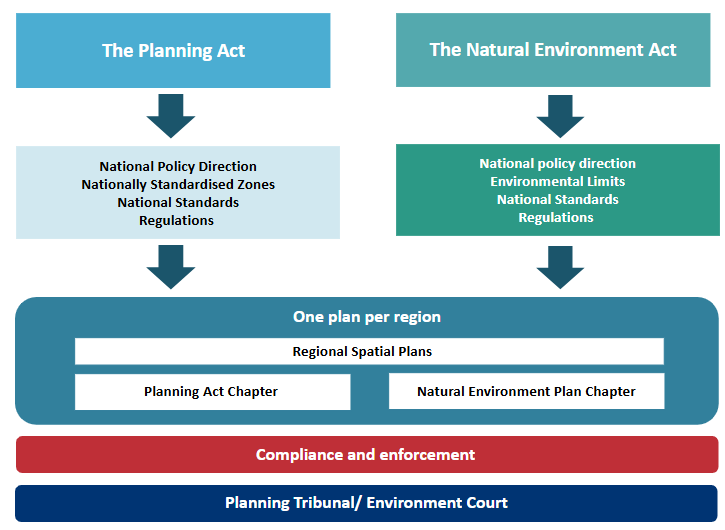
RM reform update - April 2025 Twenty-Fourth edition
The RM Reform update is for people and organisations with an interest in the reform of the resource management system. If you would like to subscribe to these updates, please click here.

The RM Reform update is for people and organisations with an interest in the reform of the resource management system. If you would like to subscribe to these updates, please click here.
Kia ora koutou,
Welcome to the second Resource Management Reform Update of 2025.
This issue focusses on the Government’s recent announcement of two new pieces of legislation to replace the Resource Management Act 1991.
Speaking at the New Zealand Planning Institute’s annual conference in Invercargill last month, Resource Management Reform Minister Chris Bishop said two new Acts would cover planning and the natural environment.
Minister Bishop said replacing the RMA will enable economic growth and make it easier to plan for, and deliver, infrastructure and housing, while protecting the environment.
Other goals for the RMA replacement legislation include establishing a system that is more nationally consistent; is less costly and complex than the current regime; is easier for a range of users to access; sets clearer limits for using natural resources and gives more certainty about how land and resources are used for development.
Critically, any future system must allow us to adapt to, and plan for, the effects of climate change, or natural hazards.
MfE staff also attended the NZPI conference and presented at sessions with planners. We greatly enjoyed interacting with stakeholders from a range of sectors, and Ministry staff gained many valuable insights into important issues the new system must address.
MfE will update you on legislative developments and opportunities to provide feedback as this work progresses.
Ngā mihi nui, nā
Nadeine Dommisse,
Deputy Secretary, Environment Management and Adaptation
The Government announced plans to replace the Resource Management Act 1991 with two new Acts last month.
Bills to develop this legislation is expected to be introduced to Parliament later this year, and the new Acts are intended to be law by mid-2026.
The Government established an Expert Advisory Group (EAG) in September 2024 to prepare a blueprint to replace the RMA, based on the objectives and principles set by Cabinet.
The EAG, chaired by resource management barrister Janette Campbell, delivered its draft report in December.
This provided a package of 21 recommendations to deliver a system that is fit for New Zealand’s unique geography and resources.
This blueprint has formed the basis to develop the replacement resource management system.
While their final design may vary, a dual act approach has been proposed to reduce overlap between different laws and regulations and to provide a clearer framework for managing effects on the natural environment.

The new legislation may narrow the scope of the resource management system and the effects it controls.
Each new Act could have a set of national policy direction to simplify and direct local government plans and decision-making and provide guidance on how to resolve conflicts between competing priorities.
National Direction under the new Planning Act will cover urban development, infrastructure – including renewable energy – and natural hazards.
National Direction under the Natural Environment Act will cover freshwater, indigenous biodiversity and coastal policy.
Targeted proposals will be progressed to have immediate effect on certain instruments while the new resource management system is developed and implemented.
Consultation documents relating to the national direction programme are expected to be released in mid-2025.
You can find further information on the national direction programme.
The new legislation will introduce nationally standardised planning zones.
Each region will have a combined plan, that includes:
Shifting the focus of policy setting to a national level will enable local decision making to focus on local issues, and reduce the number of plans nationwide.
Resource consents will still be required under the news system, but there will be fewer of them because there will be more permitted activities, nationally standardised land use zones and more national standards.
The number of consent categories will be reduced.
People who are not directly affected by a consented activity will not be able to object to the application or relitigate an outcome.
A national compliance and enforcement regulator could be established.
Environmental limits describe a minimum acceptable state, or the maximum acceptable harm or pressure on the natural environment.
Under the RMA, limits have been set for national direction for air quality, freshwater, soil, and some aspects of biodiversity.
The Expert Advisory Group recommended the new system have a better system for natural resource allocation and charging for use, and provide a better legal framework for setting environmental limits to protect natural resources and give more certainty about where development can and should be enabled.
In addition to environmental limits for air, freshwater, soil, biodiversity and ecosystems, the NEA could include environmental controls to protect significant natural values, including significant natural areas (SNAs).
Further information is available on the Ministry website:
Several national direction instruments will be changed before the Acts to replace the RMA 1991 commence in 2026.
On 24 March 2025, Cabinet reconfirmed the scope of these changes to national direction instruments that will be progressed in 2025.
A factsheet on the key changes is available here.
The changes and are intended to have immediate effect on the resource management system, while the new resource management system is developed and implemented.
Submissions on the Resource Management (Consenting and Other System Changes) Amendment Bill closed on 10 February with Select Committee hearings held in February and March.
The Select Committee is expected to provide its report to Parliament in mid-2025. For more information visit the Environment Select Committee page here.
The Fast-track Approvals Act 2024 commenced last December.
From 7 February, any person can apply to have development and infrastructure projects considered for fast-track approval.
The Fast-track website has a range of information about the resources and tools available to applicants and other participants in the Fast-track process.
These tools include an application portal and case management system to receive and manage applications through the process, and a time-sheeting system for government agencies, councils and others who will charge for their time and costs associated with processing applications.
Information on the Fast-track applications process is available here.